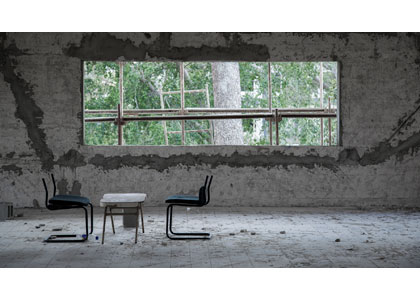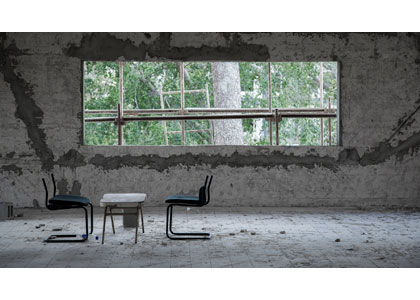Deceased no. 57
Curator: Or Tshuva
14/09/2017 -
16/12/2017

Arnon Rabin’s Deceased no. 57 joins a long sequence of scholarly projects featured in the museum’s Collection Gallery, offering a self-scrutiny of the museum, its resources, and its setting. Staged as part of an exhibition series centered on habitats emptied of their original occupants and purpose, it introduces one such local case study: the old dining room of Kibbutz Giv’at Hashlosha, located just across the street from Petach Tikva Museum of Art.
Kibbutz Giv’at Hashlosha underwent a schism in the early 1950s. Its members left the kibbutz’s original grounds and set up two separate kibbutzim: Giv’at Hashlosha and Einat, while the historical site of the kibbutz was swallowed up by the municipal jurisdiction of the developing
city of Petach Tikva. Throughout the years in which it stood deserted, the unique dining room (designed by architect Arieh Sharon) has been the focal point of public struggles for control. Via a seven-minute one-shot video installation, Rabin attempts to skirt the prevalent discourse of urban gentrification and the decline of the kibbutz vision, while simultaneously avoiding the romantic awe reserved for the aesthetics of ruins and deserted buildings. Instead he unfolds the history of the dining room through the chronicles of the Canary palm planted next to it.The tree was infested with the red palm weevil whose larvae gnaw at the palm from the inside, rendering it rickety, much like the dining room itself. Once the fate of the building was etermined and its reconstruction was set in motion, the fate of the tree was decreed as well. Rather than being “restored,” however, a permit was issued for its removal, in which it was referred to as “Deceased no. 57.” The work was filmed as the ruling was being implemented. As the video begins, the palm tree is seen towering firm and steady, but at the end the tree is lying on the ground. The cyclical camera movement alludes to another cinematic image involving death: the iconic penultimate shot of Michelangelo Antonioni’s film The Passenger (1975), which concludes with the protagonist’s death. Instead of following the murder act itself, however, the camera leaves through the hotel room window when the protagonist is still alive, and returns to the same window after a seven-minute cyclical tracking shot, only to find him lying dead on the bed.
In effect, the death of “Deceased no. 57” took place out of sight long before it was felled, when its insides were gnawed. The soundtrack of the work—based on sound samples produced by a technological development intended to eradicate the pest, which isolates the weevil’s unique sonic frequencies—forms yet another layer in the oscillation between interior and exterior, the overt and the covert, typifying a project underlain by a vision of an invisible death.


